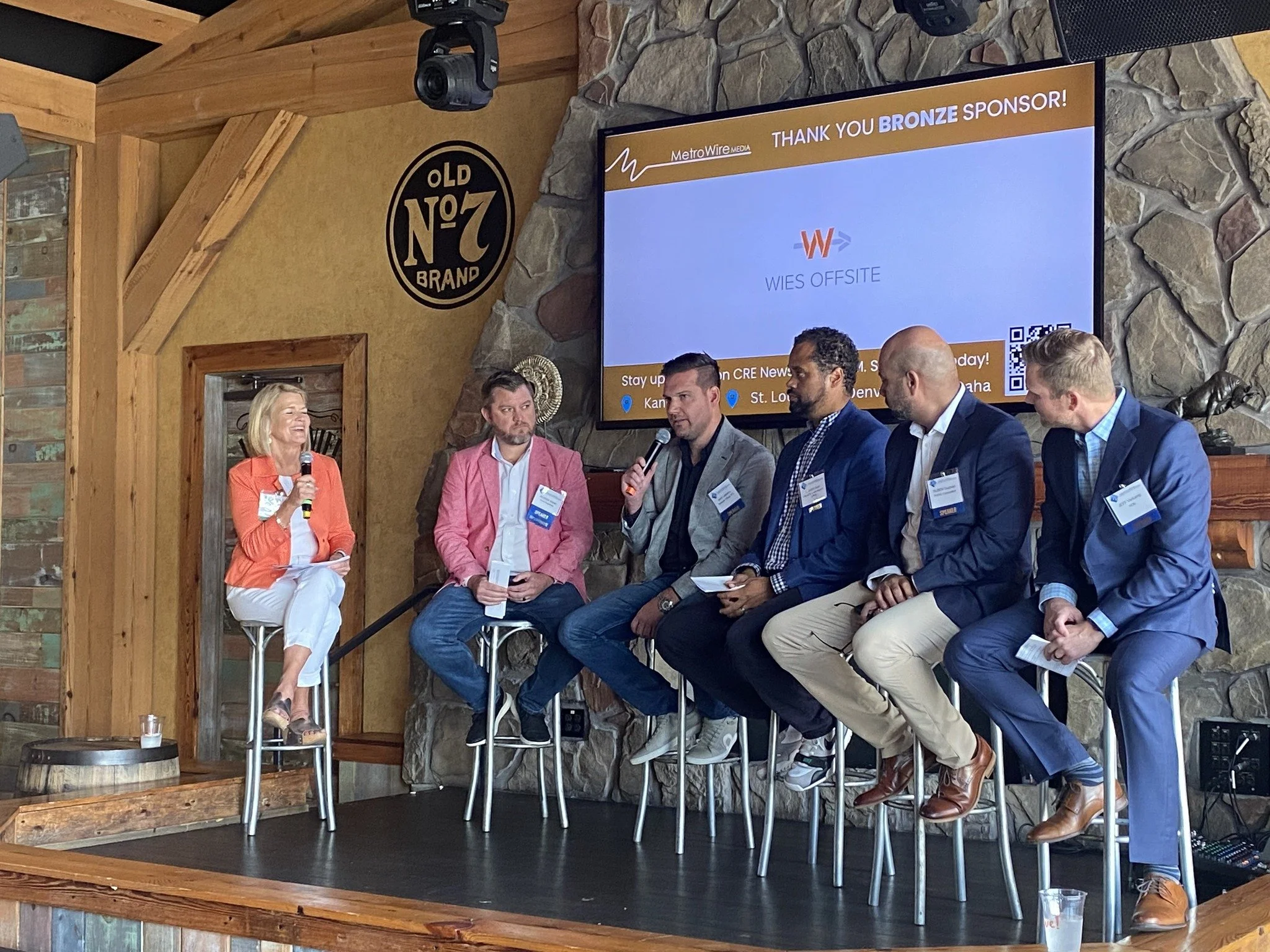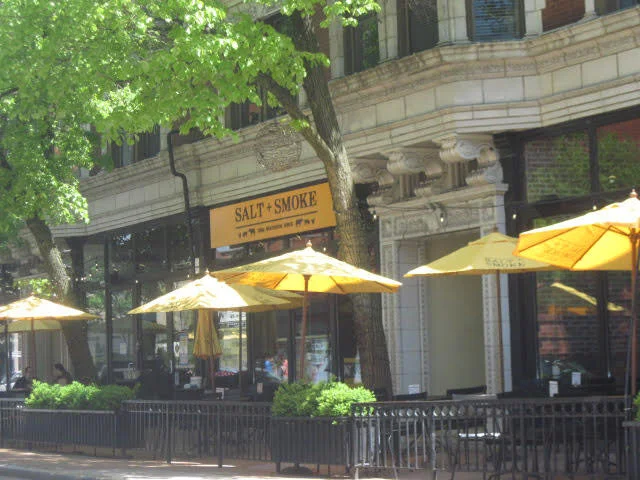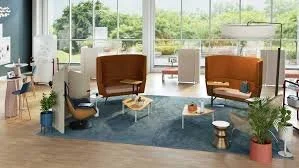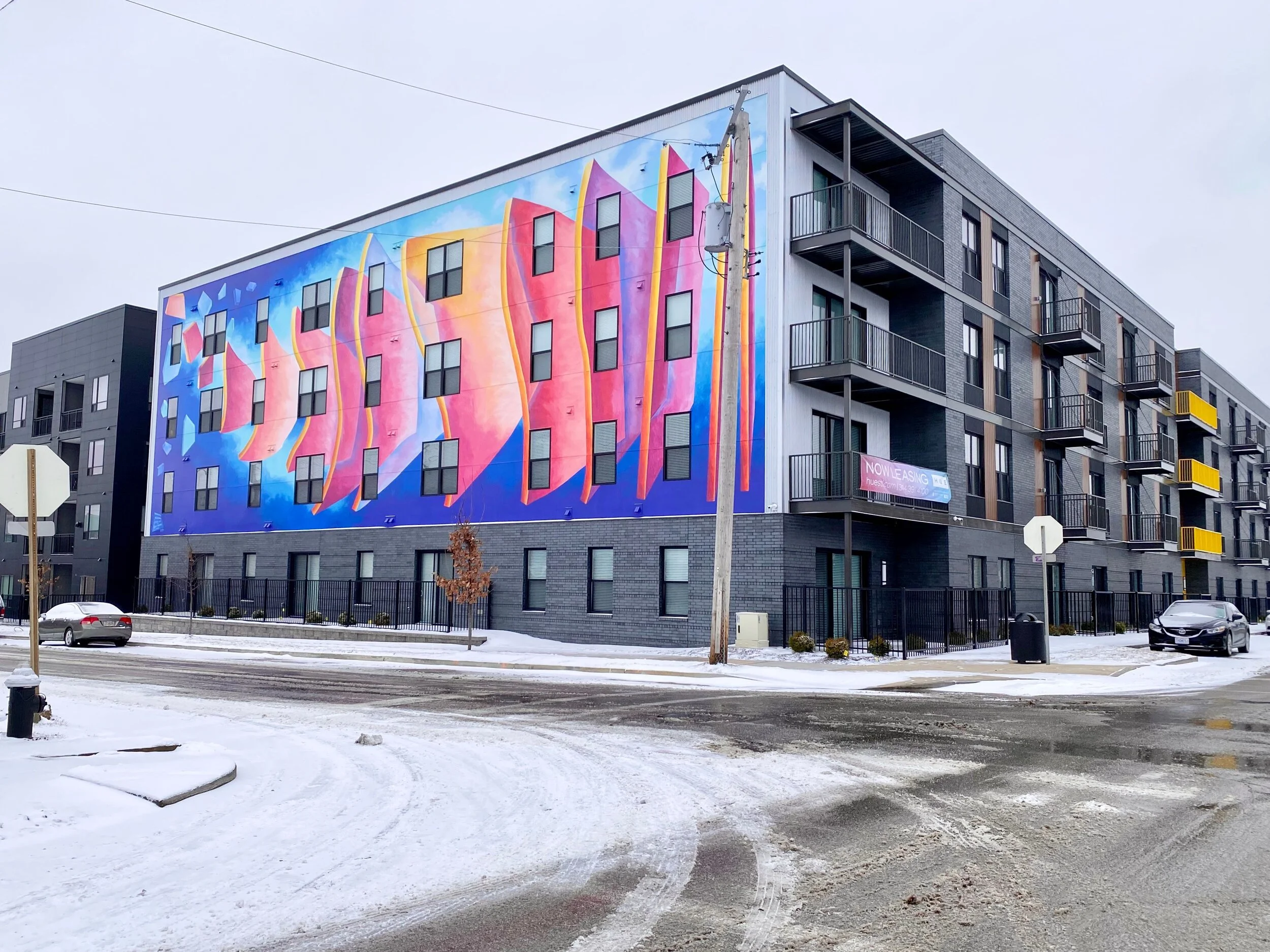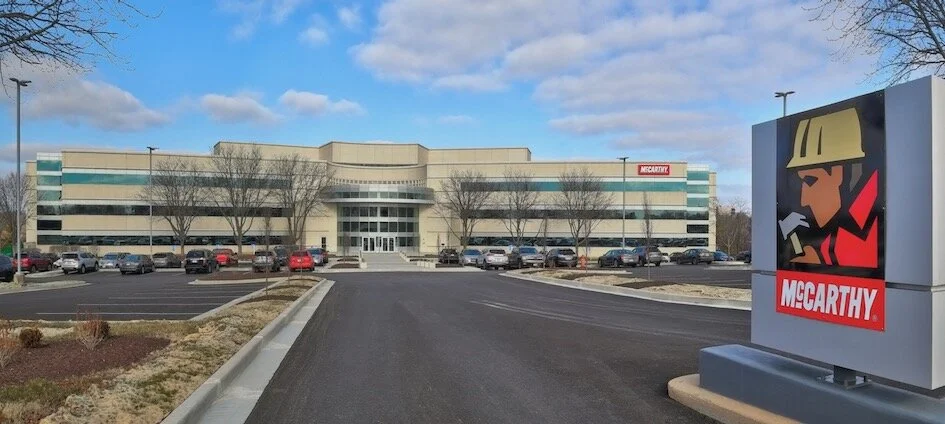FEATURE PHOTO CREDIT: MWM STL | LISA SHACKELFORD
SIOR panelists voice 'biggest changes ever' in commercial real estate
Urban League senior apartments, community center break ground in Dellwood
Last week, KAI joined the Urban League of Metropolitan Saint Louis to break ground on the organization’s new senior apartments and community center located at 9947 West Florissant in the City of Dellwood in North St. Louis County.
KAI is providing design-build services on the 40,000-square-foot facility which is expected to be complete by December 2022.
The $10 million, three-story building will include 44 resident units (40 one-bedroom units and four two-bedroom units), plus a community room on the main level for 12-15 people and a resident lounge with a kitchenette and restrooms. The main level will also include a private manager’s office, reception area, workroom and shared access to the community room.
At a time when the shortage of affordable housing in communities around the United States regularly makes the headlines, another less visible housing crisis is also intensifying, according to KAI CEO Michael Kennedy, Jr.
The number of elderly people with ‘worst case housing needs’—defined as renters with low incomes who do not receive government housing assistance and pay more than one-half of their income for rent, live in severely inadequate conditions, or both—is increasing rapidly. Nearly 10 million households with an occupant over age 65 spends more than 30 percent of their income on housing; roughly 5 million of those households spend more than 50 percent.
“The growth in the population of Americans aged 65 or older is projected to reach nearly 73 million in 2030, and more than 83 million in 2050, which means that senior households increasingly will be renters,” Kennedy said.
“Resources for housing and supporting our aging population are scarce in relation to the scope of the problem. To the Urban League and its board members and donors, the Missouri Housing Development Commission and Michael Gardner and his team at Gardner Capital, St. Louis thanks you; this community thanks you; and I thank you for partnering with KAI to bring seniors in this community this much needed project,” Kennedy said.
The Urban League of Metropolitan Saint Louis’ mission is to empower African Americans and others throughout the region in securing economic self-reliance, social equality and civil rights. The organization is committed to investing in the continued redevelopment of the West Florissant Corridor through Dellwood and Ferguson.
The goal of the development is to give seniors in Dellwood not only the opportunity to live in a brand new building but to also have easy access to many services and programs offered by the organization, including the popular Senior Empowerment Series.
Presenters at the groundbreaking ceremony also included Urban League president & CEO Michael P. McMillan; St. Louis County Executive, Sam Page; St. Louis County Council Chair, Rita Heard Days; City of Dellwood Mayor, Reggie Jones; and Missouri State Senator, Brian Williams.
TriStar brings new industrial park to Maryland Heights
Holland Construction Services celebrates 35 years
Thirty-five years ago, Holland Construction Services began as one man’s vision to build a construction company based on integrity, trust and long-lasting relationships. Today, the company has grown to become one of the most respected and sought-after contractors in the St. Louis region and Southern Illinois.
Bruce Holland, founder and CEO, began the company in 1986 as a full-service general contracting company and quickly grew as one of the Midwest’s pioneers in the Construction Management delivery method. His goal was to give honest bidding, transparency, and in turn, develop trusted relationships with both his clients, and the subcontractors and architects they worked with.
“A core part of our business philosophy from the beginning was handling projects with integrity,” said Holland. “Over 35 years, 90 percent of our business is repeat clients. I think that’s because our team always operates with empathy by putting ourselves in our clients’ shoes, and making sure we are listening to what is important to them, whether that be a completion date, or something that has historical significance. We deliver without excuses and make it happen.”
Part of the company’s success can be attributed to its adaptability. Over the years, the company’s areas of expertise have continued to evolve and expand from primarily retail projects in the beginning, to schools, healthcare facilities, multifamily, senior living, recreation, public safety and industrial projects.
As a result, the company now has a footprint throughout the St. Louis and Southern Illinois region on a variety of significant developments. Several high-profile projects completed in the past few years include the new 144-bed HSHS St. Elizabeth’s Hospital and medical office building (MOB) and new 94-bed Memorial Hospital East and MOB both in Illinois; Volpi Foods new meat slicing and packaging facility in Union, MO; numerous luxury apartment complexes across the St. Louis area (Whispering Heights in Edwardsville, Villages of Twin Oaks, Chroma Apartments near downtown St. Louis, and Encore at Forest Park); recreation complexes for the cities of Bridgeton and Fairview Heights; and senior living communities in O’Fallon, IL as well as in the Cincinnati and Columbus, Ohio areas.
“We have a growing Virtual Design & Construction (VDC) Department that has played a vital role in our ability to tackle larger, more complex projects,” said Mike Marchal, Holland president. “Over the years, our adoption of technology across all departments has allowed us to catch issues before they become problems and to deliver on our clients’ objectives with certainty.”
Holland fosters a family-friendly culture and has introduced unique programs throughout the years to encourage a work/life balance. In 2016, as part of their 30-year anniversary, Holland introduced a 3-week paid sabbatical program available to employees for every five years at Holland, along with a stipend to use for their trip. Additionally, in keeping with Bruce Holland’s life-long personal commitment to community philanthropy and involvement, Holland encourages volunteerism and opportunities to give back, establishing the Holland Employee Charitable Foundation (HECF) several years ago with the mission of helping others in the community. The firm’s charity golf tournament, The Klondike Klassic, has raised more than $225,000 for local charities, now topping $25,000 annually.
“There has been a world of positive changes since we started the company but the thing that impresses me the most is the quality of people we have and watching them grow and expand their careers, “said Holland. “The special culture we have created here has allowed for the planned growth of our people and our company, year by year, while also creating an environment where individuals can grow professionally and have the ability to give back.”
Holland is led by founder and CEO Bruce Holland, President Mike Marchal, and Vice President & Project Executive Doug Weber. Marchal, who joined Holland in 1997 and became president in 2011 after working his way up through the ranks, believes all the important ingredients are in place for continued growth nationally.
“We are in the process of finalizing plans to open an office in St. Louis this year,” said Marchal. “Also, based on our previous work with several clients who are also expanding their businesses, we have opportunities for strategic growth in other areas around the country including Ohio, Tennessee, Florida and Arizona. We are a growing company, but our reputation of integrity, creating opportunities, and helping our community are the lifeblood of our business and Bruce’s legacy, and that won’t ever change.”
For more information, visit Holland’s website at www.hollandcs.com.
O'Toole Design to join Green Street St. Louis
Spring has sprung business again for area restaurants, retail
S. M. Wilson & Co. named among top places for women to work
Ryan Companies breaks ground on multi-specialty medical building in St. Peters
Office conundrums: should we stay or should we go?
St. Louis CRE organizations install 2021 leadership
Sybrandy sees attractions driving CRE rebound
Since joining Koch Development Co. in 2012, Mandy Sybrandy has built a specialized team of managers and staff to operate SkyWheel® Attractions.
SkyWheel® started as a stand-alone iconic attraction in May 2011 with SkyWheel Myrtle Beach. Over the years, it has evolved into a full-service entertainment venue with a ropes course, Snack Shack and an 18-hole miniature golf course in its Panama City Beach, Fla. location.
Clayton, Mo-based Koch Development, who retains an ownership interest of SkyWheel, became the first company to bring an observation wheel of its type to the United States, with locations in Myrtle Beach, S.C. and Panama City Beach.
“Retailers and landlords see tremendous value in such iconic attractions because they attract customers to the location for entertainment and then capture their visit for traditional retail spending, especially as vacations and travel adapt post-COVID,” Sybrandy said.
According to its website, the SkyWheel® is not a carnival ride, but a modern, safe observation wheel towering almost 200 feet in the air with fully-enclosed gondolas offering a safe and secure flight with glass windows and doors for optimal views and photography. The gondolas are heated and cooled, allowing for year-round operation.
Sybrandy, who was recently promoted to vice president of attractions and installed as an officer of Koch Development, said that there are no current attraction opportunities under review in St. Louis.
“SkyWheel® is capitalizing on the power of bringing an experience to locations such as our location at Pier Park in Panama City Beach, Fla., where SkyWheel® enhances the marketability of traditional commercial real estate,” Sybrandy said.
Sybrandy sees great pent-up demand for travel now.
“Staycations and domestic travel within driving distance are accelerating,” Sybrandy said.
As a result, Sybrandy expects the Myrtle Beach and Panama City Beach locations to rebound this year.
Sybrandy graduated from Saint Louis University with a bachelor’s degree in organizational studies and a minor in hospitality management. She is a member of the International Association of Amusement Parks and Attractions and of the National Association of Amusement Ride Safety Officials, which focuses on operations.
Now entering its second century in business, Koch Development is a St. Louis-based, third-generation, family-owned company that develops, owns and manages a diverse portfolio of commercial real estate and entertainment attractions.
Green Street anticipates exponential growth for 2021
McCarthy moves national headquarters to new office space
St. Louis Coalition creates toolbox to shape community development
The Neighborhood Toolbox, the St. Louis Neighborhood Organization Map, and St. Louis Community LAB can be found at http://investstl.org/neighborhood-toolbox/.
Soulard Commerce Center bridges e-commerce, consumer gap
Soulard Commerce Center, a Class A warehouse building located in the 35-acre Soulard Business Park, is complete and available for leasing, according to JLL.
Developed by The Opus Group, the 154,937-SF spec warehouse is the first modern industrial building in the area since 2004. The building can accommodate final-mile destination warehouse and delivery, light manufacturing or general office/warehouse uses.
“This area of the city, and for that matter points further south in the city and county, are the most supply constrained in our market when it comes to modern industrial building product. It is a swath of the market with significant barriers to developing at scale, and The Opus Group has achieved that in Soulard Commerce Center. In the process, they’ve created a unique alternative for industrial occupiers who previously had to consider locations further away from their customer and employee bases,” said Pat Reilly, executive vice president of industrial leasing for JLL.
Soulard Commerce Center is designed for multiple tenants with individual build-to-suit spaces starting at about 22,000 SF. It features 32-foot, clear-height ceilings and 24 trailer parking stalls to suit a variety of uses, including e-commerce and urban logistics.
With easy access to Interstates 44, 55, 70 and 64, the building location can meet the distribution needs of modern final-mile networks, which have become more important with the explosive growth of e-commerce.
“The recent boom in e-commerce has created an increased demand for modern industrial space,” said Ryan Carlie, director of real estate development at Opus. “Soulard Commerce Center provides tenants a diverse space that can accommodate a variety of needs within a convenient and desirable location.”
The building benefits from 25-year real estate tax abatement. Base rent for the building is $6.50 per square foot.
Auditorium renovations complete at WUSM
Construction is complete on a project to renovate two underutilized auditoriums and vacant space at Washington University School of Medicine (WUSM) in St. Louis into a Training and Testing Center that will support the medical school's new mission and active learning curriculum.
Cori Auditorium and Erlanger Auditorium, which were both underutilized due to their age and outdated design for current teaching methods, are located on the first floor of the school's McDonald Science Building, designed in 1960. Named for the distinguished Nobel Prize-winning WUSM faculty Joseph Erlanger and Carl and Gerty Cori, the auditoriums still functioned as lecture halls before the renovations.
In addition to the two auditoriums' reconfiguration, KWK Architects designed a testing center for medical education in the building's vacant space after relocating the admissions office to the North Building on campus and the student services location to Becker Library. The ground-floor access and central location made it a prime location for the medical school's new Training and Testing Center.
"The university's teaching pedagogy has shifted from a stand-and-deliver approach of the past to a more collaborative, interactive teaching method, as evident in the design renovations for the vacant space and two auditoriums," said KWK Architects principal Eric Neuner.
KWK designed the vacant space into an 85-seat testing room for medical students, which could also be used as seminar and lecture space for all departments. KWK acoustically engineered the area to eliminate sounds from the corridor and adjacent auditoriums. The interior was passively reinforced with built-in reflectors and diffusive shapes to help strengthen speech. The space also provides multiple video screens for lecture functions and splitting the room up into workgroups as needed.
To create fully accessible and flexible active learning classrooms in the auditoriums, infilling the existing slopes and reconfiguring the room shapes was required. Structurally engineered, cold-formed framing supports were installed with a lightweight concrete topping to provide the floor infill. The interstitial space was lined with insulation to help reduce sound transmission during construction and final use.
"This had to be done carefully since the basement below the spaces housed existing laboratories which were operational throughout the construction process," said KWK project manager Bob Buckman.
Cori Auditorium, the larger of the two auditoriums, takes advantage of existing windows to connect the occupants to the exterior. Two new windows were installed in Erlanger Auditorium to give the interior a connection to the outdoor courtyard.
"What was once a dark, antiquated auditorium is now an open, well-lit space both naturally and artificially. The renovated spaces are now ready to serve the medical school for the next 50 years," said Neuner.
Tables and chairs on casters were specified for each new classroom (138 seats in Cori and 105 seats in Erlanger) to provide flexibility in configuration. Motorized shades and dimmable lighting were also selected for multi-use functionality in each space. The Medical School's logo was added as a wall graphic to each classroom to reinforce its branding.
AVI Systems of St. Louis provided the design for the center's new AV systems, which include a 3 ft x 3 ft video wall interconnected to 96-inch screens placed throughout each classroom. The education component is supported by active sound reinforcement and built-in cameras for online learning.
"Screens were placed in careful planning with the furniture to ensure good sightlines with writable wall surfaces. Each smaller breakout area can share their screens with the video wall for interactive learning," said Buckman.
The project team also included SSC Engineering, Bell Electrical, C&R Mechanical, Dynamic Controls and Engineered Fire Protection. The general contractor on the project was BSI Constructors and Interface Construction.
In 2015, Washington University School of Medicine hired KWK Architects to develop a phase one-campus plan https://outlook.wustl.edu/building-connections/.
Since the master plan's completion in 2015, KWK has worked on over 40 design and study projects on the School of Medicine Campus. These include projects outlined in the master plan and additional enabling projects that have helped support campus growth and recruitment activities.
“The projects just completed by KWK were the final phase of the 2015 Phase One Education Renovation Plan. We are excited to see the full plan come to fruition and are eager for the campus to use and experience these exciting spaces,” said Melissa Rockwell Hopkins, assistant vice chancellor of operations facilities with the School of Medicine.
For more information about KWK Architects' university master planning expertise, visit www.kwkarchitects.com/markets/details/master-planning.
$40 million affordable housing project heads to Central City
Building on continued momentum in St. Louis’ Central City, a groundbreaking new housing project will bring attainable housing through over 160 new units - over 80 of which will be workforce-targeted rents - to the Central City’s Forest Park Southeast neighborhood.
Union At The Grove, a $40 million multifamily development, is comprised of six individual buildings on Hunt, Vista and Norfolk Avenues, between Newstead and Taylor Avenues, just east of Kingshighway.
Green Street St. Louis developed the project with support from a consortium that includes Greater St. Louis, Inc., IFF, and Washington University Medical Center Redevelopment Corp. (WUMCRC), a partnership between BJC Healthcare and Washington University School of Medicine in St. Louis.
“As we focus on inclusive economic growth for our region, the project sends a strong signal about what is being done to begin a resurgence in the Central City in St. Louis,” said Valerie E. Patton, Chief Diversity, Equity and Inclusion Officer for Greater St. Louis, Inc. and president of the Greater St. Louis Foundation.
In addition to Union, recent developments highlighting the resurgence in the Central City include the first fully protected bike and pedestrian infrastructure in the city that will connect the Tower Grove Park and the Shaw neighborhood to Forest Park Southeast and Cortex; continued significant development taking place in and around Cortex itself; the construction of the new NGA West headquarters, projected to open in 2025; and additional hundreds of millions of dollars of new and adaptive re-use real estate development underway in the City. As has been reported in recent years, more than $8 billion in development is underway, planned or has been recently completed in the City.
“Union At The Grove is a natural extension of Green Street’s continued commitment to the City of St. Louis and Midtown redevelopment through partnership and community revitalization,” said Joel Oliver, Green Street senior vice president for development.
Developing new workforce housing is critical to inclusive growth, and approximately 52 percent of the Union’s units will have attainable rents so that health care employees and medical school staff can live near where they work. The units with attainable rates will be blended throughout each of Union’s six unique buildings.
Amenities include private entrances, courtyards and walking paths; shared rooftop terraces, balconies, and barbecue areas; and bike storage, mail, and secure package areas. The properties are walking distance from Forest Park, Tower Grove Park, Cortex and the Washington University Medical Campus.
“Social, environmental and economic inequities are recognized as major contributors to health disparities,” says Richard Liekweg, BJC HealthCare president and CEO.
“This project demonstrates that health care organizations can play a part in strengthening our neighborhoods and communities. Having new, attractive and attainable housing adjacent to our academic campus where some 20,000 employees work will facilitate access to jobs, while also strengthening communities,” Liekweg said.
Beginning in 1996, WUMCRC has purchased properties in the neighborhood with the long-term goal of attracting developers with strong records in redeveloping and supporting mixed-income, diverse communities. Union At The Grove is the final segment of this effort to improve the quality of life for residents in neighborhoods that border the Medical Campus. WUMCRC also has supported neighborhood investments in safety, jobs, education and the development of The Grove, the entertainment and commercial district along Manchester Road.
“In recent years the market has done a great job supplying high quality market rate and we have been able to find resources to build and maintain low-income housing units in the neighborhood. This project fills in the missing middle – those who earn too much to qualify for subsidized housing and too little to afford market housing,” said Hank Webber, Washington University’s executive vice chancellor and chair of the WUMCRC board.
Construction is slated to start February 1, 2020 with an official groundbreaking ceremony targeted for spring of this year. The project did not make use of federal or state tax credits or incentives and is applying all funds from the 10-year tax abatement it received into the newly formed Newstead West Community Improvement District for the purpose of making infrastructure improvements that would otherwise not be completed. These improvements include:
Resurfacing of streets and alleys
Rebuilding sidewalks and curbs
Installing new streetlights
Helping heal the City’s grid by reopening the cul-de-sacs on Vista and Norfolk at Taylor
“This development checks a couple of important boxes for our community. It adds density to support our efforts for more environmentally sustainable development and less car dependency. It also has a workforce housing component to assure our neighborhoods remain economically diverse. Both are core values of the 17th Ward,” said 17th Ward Alderman Joe Roddy.
Development of Union is being led by Green Street, which has advanced approximately $100 million worth of other projects in the Forest Park Southeast neighborhood. Green Street Building Group is managing project construction with said construction financing provided by Colliers International, arranged by Kyle Howerton of George Smith Partners.
IFF provided Newstead West Community Improvement District a bridge loan to provide upfront funding for infrastructure improvements that would have otherwise been available spread out over a decade.
CentralCitySTL is an initiative of the newly formed economic development organization Greater St. Louis, Inc. that combines the work of Arch to Park and Design Downtown STL. The Arch to Park Equity Fund made a patient capital investment to help make this major development possible.
Electrical Connection creates turn-key EV charging stations
Featured in photo from left to right: Scott Drachnik, president and CEO of St. Charles County Economic Development Council; Jim Curran, executive vice president of Electrical Connection; Kevin Bresnahan, project manager at RJP Electric; Scott Nesbitt, IBEW Local I; and Randy Bowers, operations manager at RJP Electric.






